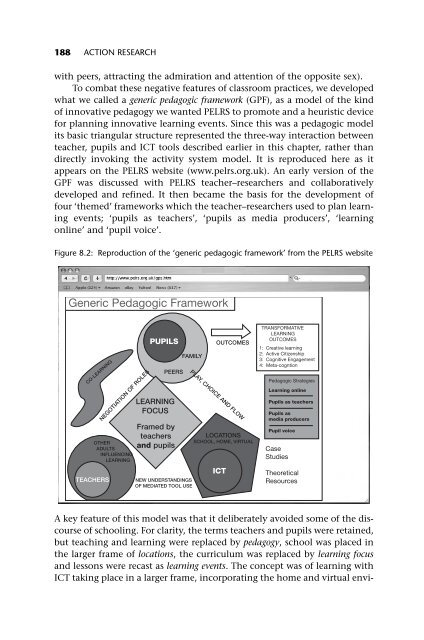Action Research A Methodology for Change and Development
Action Research A Methodology for Change and Development
Action Research A Methodology for Change and Development
Create successful ePaper yourself
Turn your PDF publications into a flip-book with our unique Google optimized e-Paper software.
188 ACTION RESEARCH<br />
with peers, attracting the admiration <strong>and</strong> attention of the opposite sex).<br />
To combat these negative features of classroom practices, we developed<br />
what we called a generic pedagogic framework (GPF), as a model of the kind<br />
of innovative pedagogy we wanted PELRS to promote <strong>and</strong> a heuristic device<br />
<strong>for</strong> planning innovative learning events. Since this was a pedagogic model<br />
its basic triangular structure represented the three-way interaction between<br />
teacher, pupils <strong>and</strong> ICT tools described earlier in this chapter, rather than<br />
directly invoking the activity system model. It is reproduced here as it<br />
appears on the PELRS website (www.pelrs.org.uk). An early version of the<br />
GPF was discussed with PELRS teacher–researchers <strong>and</strong> collaboratively<br />
developed <strong>and</strong> refined. It then became the basis <strong>for</strong> the development of<br />
four ‘themed’ frameworks which the teacher–researchers used to plan learning<br />
events; ‘pupils as teachers’, ‘pupils as media producers’, ‘learning<br />
online’ <strong>and</strong> ‘pupil voice’.<br />
Figure 8.2: Reproduction of the ‘generic pedagogic framework’ from the PELRS website<br />
Generic Pedagogic Framework<br />
CO-LEARNING<br />
TEACHERS<br />
NEGOTIATION OF ROLES<br />
OTHER<br />
ADULTS<br />
INFLUENCING<br />
LEARNING<br />
PUPILS<br />
PEERS<br />
LEARNING<br />
FOCUS<br />
Framed by<br />
teachers<br />
<strong>and</strong> pupils<br />
FAMILY<br />
NEW UNDERSTANDINGS<br />
OF MEDIATED TOOL USE<br />
OUTCOMES<br />
PLAY, CHOICE AND FLOW<br />
LOCATIONS<br />
SCHOOL, HOME, VIRTUAL<br />
ICT<br />
TRANSFORMATIVE<br />
LEARNING<br />
OUTCOMES<br />
1: Creative learning<br />
2: Active Citizenship<br />
3: Cognitive Engagement<br />
4: Meta-cogntion<br />
Pedagogic Strategies<br />
Learning online<br />
Pupils as teachers<br />
Pupils as<br />
media producers<br />
Pupil voice<br />
Case<br />
Studies<br />
Theoretical<br />
Resources<br />
A key feature of this model was that it deliberately avoided some of the discourse<br />
of schooling. For clarity, the terms teachers <strong>and</strong> pupils were retained,<br />
but teaching <strong>and</strong> learning were replaced by pedagogy, school was placed in<br />
the larger frame of locations, the curriculum was replaced by learning focus<br />
<strong>and</strong> lessons were recast as learning events. The concept was of learning with<br />
ICT taking place in a larger frame, incorporating the home <strong>and</strong> virtual envi-

















